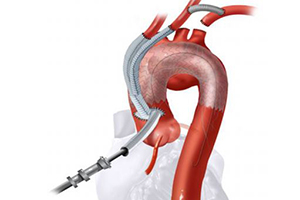Type II arch hybrid debranching procedure
Abstract
Management of aortic arch aneurysm and dissection continues to evolve as endovascular options play an increasing role in treating thoracic aortopathies. Although conventional open treatment of aortic arch disease with total arch replacement still remains the gold standard, in patients with old age and/or high comorbid disease index, there is significant associated morbidity and mortality. The hybrid arch procedure, which aims to minimize cardiopulmonary bypass and circulatory arrest times, is a particularly appealing surgical option in this cohort of patients. The hybrid arch concept essentially entails three main principles: (I) open debranching of the great vessels; (II) creation of proper proximal (zone 0 landing) and distal landing zones, and; (III) concomitant or delayed endovascular stent grafting of the aortic arch. The classification scheme for hybrid arch debranching procedures is based on the extent of proximal and distal landing zone reconstruction required, and thus the need and extent of cardiopulmonary bypass and circulatory arrest management strategies to be employed. In this illustrated article, we describe the details of the type II hybrid arch debranching procedure, where the ascending aorta and aortic arch pathology is typically treated by reconstruction of ascending aorta ﹢ arch vessel debranching, with concomitant antegrade stent grafting of the aortic arch.
Cover






